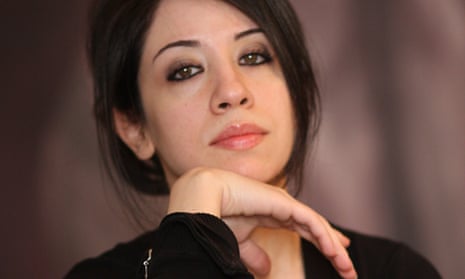One of Syria’s most well-known and striking artists, now exiled in the Lebanon, will bring her unsettling new work to Britain next month, in an attempt to share her experience of loss and fears for the future. Sara Shamma, once a leading lights of the art scene in Damascus, has given her show the title World Civil War Portraits to reflect her belief that the conflict tearing her city apart has wider implications, not only in the Middle East, but in Europe.
“This conflict is spreading all over the world,” the 39 year old told the Observer this weekend, “and, as it spreads, even to a country like France, the fear is spreading, too. I describe it as a World Civil War because the people attacking each other are often from the same country. This is what I want people to be more aware of, rather than some idea of terrorism from far away.”
Shamma, who was shortlisted for the BP portrait prize in London in 2004, moved out of Damascus with her two children in 2012, when a car bomb exploded outside her house. It was not an easy decision.
“A number of terrible moments pushed me to it, starting with the noises of fighting we would hear in the night. My husband and I took our children to a safe place, when it was very bad, and I painted my daughter that night, rather than sleeping,” she said. The key moment came a few days later.
“I was going to my studio with the children when, suddenly, we heard explosions. We were very close to the bomb. One week after that, we took the decision to go. It is fanaticism. In my work, I do not criticise one particular group because it is the whole situation I don’t like. It is another country now.”
Her husband, who works in the haulage industry, still travels to Damascus regularly, bringing vital goods into the city. “He has to go through 10 checkpoints and I ask him to ring me regularly so that I know he is OK.”
Shamma’s disturbing paintings, described recently by art historian Edward Lucie-Smith as a “courageous reaction to what is happening now”, are not conventional depictions of war. Instead, they are instead personal studies of the faces of those who are living the ghosts of normal, safe existences and who have been deeply affected by violence. Sometimes the pictures play with time, presenting two images of the same subject. “Her recent paintings are not in any way journalistic,” said Lucie-Smith, “but they resonate with the tragedy of the current situation.”
With a sharp irony, as the light of creative life dims in Syria after four years of unrest, a brighter international spotlight has been trained on the work of the country’s artists. While many have left the country to live and work, like Shamma, in Beirut, others are clinging to their previous lives. Some, such as Issa Touma, an artist from Aleppo, who were initially determined not to desert their homes, now find themselves potentially trapped, since countries such as the Lebanon, which is now home to at least 2.5m Syrians, have introduced stricter entry criteria for refugees.
Last month in New York, the private Jalanbo Collection, which features 700 pieces of Syrian and Middle-Eastern art, joined forces with the Armory Show to stage tours for collectors, while the British Museum has recently purchased Syrian works as part of a collection of “uprising art”.
In Aleppo, Touma staged his 12th International Photo Festival in January by projecting images of 100 artists on the walls of the remaining gallery in the city. The former festival site is now home to Islamist fighters. Other younger artists are forming anonymous collectives, such as Syrian People Know their Way, and displaying their work on social media sites.
Shamma said she does not expect to change anything with her art, but tries to remain positive: “Every situation can be changed. Nothing lasts forever, but it will take a lot of time to get better.
“All my paintings are human and about one person. Some might find them too strong, but ... I hope the show will touch somebody and make them more aware of all the dead – 200,000 – who have gone for nothing. I want to bring those 200 thousands200,000 who were killed in Syria to London, to Europe. I want you to see them, look to their eyes and feel their loss. I will not leave them dead, I want to bring them to life, to tell their stories, to defend their differences, to convince everybody they deserved to be alive.”
World Civil War Portraits, organised by StolenSpace Gallery, opens on 11 May at The Old Truman Brewery in east London
